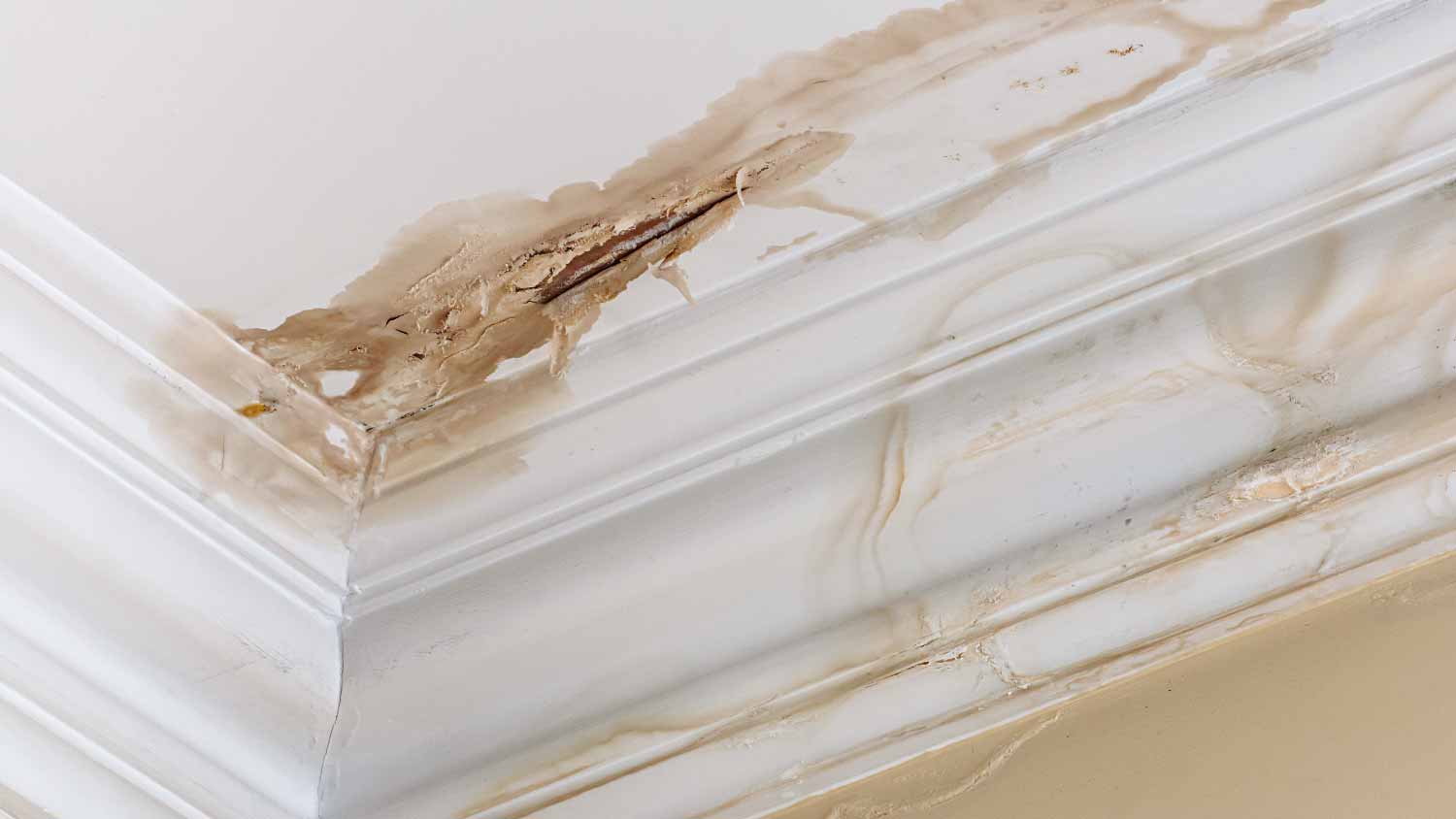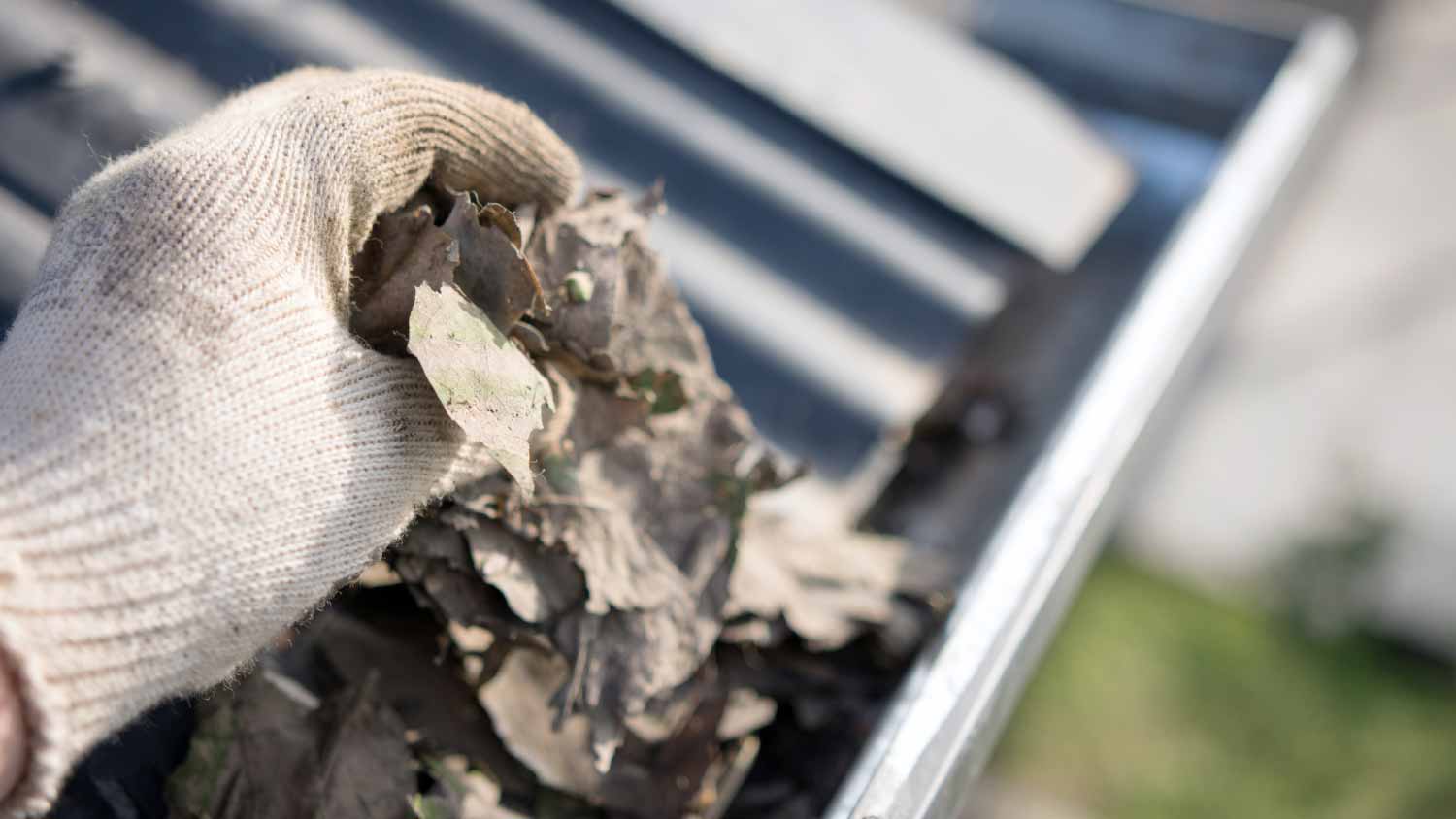8 Common Causes for Brown Spots on Your Ceiling
Learn the root causes behind the ugly brown spots on your ceiling


On average, ceiling repair costs $800 and may range from $125 to $3,000.
It costs $200 to $500 to repair leaking flashings, vents, or skylights.
Brown stains on the ceiling can either be water stains or staining from smoke damage.
Painting over the stain will just lead to repeat issues, so always treat the source of the problem first.
Brown spots on the ceiling can be unsightly, but they’re more than just an eyesore. Unfortunately, they normally indicate water damage that requires extensive repairs to treat the underlying issue rather than just painting over the stain. In this guide, we’ll explain the different causes of brown spots on the ceiling to help you identify the problem and get a permanent solution in place.
1. Leaking Water Pipes
Leaking water pipes are some of the most common causes of brown spots on the ceiling. Potential culprits include:
Busted or improperly installed water supply pipes
Leaks in drain pipes or plumbing fixtures
Poor insulation causing pipes to sweat
Soft water damaging your pipes from the inside, causing pinhole leaks
Leaking pipes are challenging to identify because they’re almost always hidden behind drywall. If you notice brown stains on the ceiling in a room beneath a bathroom or a sink, a leaking pipe is most likely the root cause. Left unattended, this could easily turn into a major water damage problem.
How to Fix It
While you can cut out portions of the stained ceiling and find the leak, chances are the repair itself requires professional help, as repairing copper and PEX requires specialized tools and experience.
Therefore, the sooner you can get a local plumber into your house, the better. Repairing a leaking water pipe behind the ceiling costs an average of $275, and most projects total between $150 and $650.
2. Leaking Roof

The second most common cause for brown spots on the ceiling is a leaking roof, and this is most likely your underlying issue if you notice the stains on the ceilings of top-floor rooms. These leaks may result from a storm damaging your roof, so stains appearing after a major storm are likely from a roof leak. Roof leaks can also happen if your roof is aging, though.
Skylights, vents, and chimneys are particularly vulnerable spots on your roof, so look to see if the brown spots are occurring around any of these roof penetrations to identify a roof leak as the cause.
How to Fix It
It’s possible to fix roof leaks yourself, but since your roof is your home’s first line of defense against the elements, it’s best to call a local roofing company to carry out a professional repair. Doing so will leave you with a nicer-looking repair and one that’s all but guaranteed not to leak again in the near future.
Fixing a roof leak costs an average of $900, although your total will depend on the severity and the type of roof you have. Patching a leak in a flat roof, for example, could cost closer to $400.
3. HVAC Units
An overflowing drip pan, a poorly installed HVAC unit, or a leaking unit could be the cause of those brown spots on your ceiling. This is likely your issue if you see the spots directly under where your HVAC unit is installed in your attic. If you have a packaged system on a flat roof and the brown ceiling spots inside are directly underneath it, you’re more likely dealing with a roof leak than an HVAC issue.
How to Fix It
For HVAC systems in the attic, you can empty the drip pan yourself and try clearing the condensate line. If those don’t fix the problem, call a local HVAC contractor to implement a permanent fix.
4. Mold Growth

If you notice brown stains on the ceiling in high-humidity areas, such as your bathroom or laundry room, they may be a sign of mold growth. Moisture in these areas can lead to rapid mold growth, which is often black but can appear brown or even green. You’re likely dealing with mold if the stains appear in small, round splotches or have a fuzzy texture.
How to Fix It
You can clean minor mold growth yourself by scrubbing the ceiling with a bleach solution and repainting the area with a stain-blocking paint. Hiring a professional for mold remediation will cost between $10 and $25 per square foot. You’ll also need to install a vent fan to prevent the problem from recurring. The average cost to install a bathroom fan is $240.
5. Smoke Stain
Brown stains on your kitchen ceiling may be smoke stains from cooking, and smoke may also be an underlying issue if you have had a minor house fire in the recent past. If you smoke cigarettes indoors, you may also notice yellow-brown spots on the ceiling where you smoke most frequently.
How to Fix It
Since smoke stains don’t indicate any underlying problems like leakages or mold, you can simply paint over them as a quick solution. You can also use vinegar and degreaser to wipe away brown smoke spots on the ceiling.
For more extensive smoke damage after a fire, contact a smoke damage restoration company to carry out a more thorough remediation.
6. Gutter Issues

Blocked gutters are another potential reason behind brown spots on your ceiling. When leaves and debris clog your gutters, water can no longer drain properly. Instead, it flows over the top of the gutter and can seep under your roof shingles and behind your fascia boards.
Clogged gutters are likely the underlying problem if you only notice brown ceiling stains close to the exterior walls of your home.
How to Fix It
The easiest way to avoid brown spots caused by gutter issues is to stay on top of regular gutter maintenance. Clean your gutters at least twice a year, or install some gutter guards to prevent blockage from large debris. Gutter cleaning costs between $75 to $395, depending on your gutter’s type, length, and height.
7. Attic Condensation
The brown spots on the ceilings in your top-floor rooms may have come from attic condensation if your house has an uninsulated attic. These spots happen more often during colder seasons when the warm air in the house rises into the attic. It then interacts with the cold surfaces and forms condensation, which can drip down onto your ceilings.
Unaddressed attic condensation can rapidly develop into severe mold problems. The mold can then travel through your house via the exhaust fan or vent system, imposing severe health threats.
How to Fix It
Insulating your attic while it’s still warm outside is the best way to prevent this issue. On average, attic insulation costs approximately $1 to $7 per square foot or $1,500 per attic. You can also install ridge vents or attic ventilation on your roof to prevent condensation from forming.
How to Prevent Brown Spots From Developing
Preventing brown spots from forming on your ceiling requires that you keep up with many different home maintenance tasks, and even then, there’s no guarantee that you won’t run into water problems that leave the stains. You’ll have the best chance of avoiding unsightly ceiling stains if you do the following.
Schedule an annual roof inspection to catch damages and potential leaks early before they cause interior damage.
Clean your gutters twice per year or install gutter guards to prevent leaks in your home.
Have an HVAC tech perform a tuneup on your system once per year to catch water problems before they become severe.
Ensure your attic is insulated or ventilated to avoid condensation from forming.
Make sure you have exhaust fans in your bathroom and laundry room and above your stove, and turn them on when moisture is present. Double-check that they vent outside.
Avoid smoking in your home.
DIY vs. Hiring a Pro
If the reason for the brown spots on the ceiling is minor, like an overflowing HVAC drip pan, you may be able to fix the issue yourself and then simply paint over the stain. You can get this done with a little elbow grease and under $50 in painting supplies.
If you can’t find the underlying cause of the water damage, or you find that a roof leak, plumbing leak, or other major issue is leading to staining, it’s best to hire a water damage restoration company to identify the cause and get a repair underway immediately. You can save some money on labor by painting over the stain once your pro fixes the root issue, but leave the actual repair work to a pro for the best results.
If you're wondering who to call for damage in the ceiling, a local plumber is generally the first choice for getting any water flow under control. A local water damage restoration company can also help determine the source of the leak and will be able to help you address water and mold damage. Based on the location and nature of the leak, you may also need to call a local roofing expert.
Frequently Asked Questions
Yes, brown spots on a ceiling are usually caused by water leaks and can lead to mold growth, especially if you don’t correct the underlying problem. Ongoing water leaks and moisture issues will almost always result in mold growth, especially if you live in a warm climate. Mold is a health hazard, so get the root problem fixed quickly, clean it, and encapsulate the area to avoid mold formation.
A stain from a water leak will usually be brown and concentrated in a single area where the water is originating from. You may find it under a damaged section of roof, under an upstairs bathroom, or beneath your HVAC system. Stains from condensation are more likely to be widespread since they don’t come from a single point of water intrusion. Condensation stains also look blotchy and may smell musty, and they won’t be concentrated in a single area on your ceiling.





- What to Do If Your New Roof Is Leaking
- Who to Call for a Water Leak in Your Ceiling
- How to Troubleshoot and Fix a Ceiling Leak
- 8 Signs of a Roof Leak and What to Do About It
- How to Fix a Leaking Roof From the Inside
- 7 Reasons Why Water Is Rising Through Your Floor—And How to Fix Them
- Roof or Windows? 10 Tips for Finding a Sneaky Water Leak Around the House
- 3 Reasons Why Your Light Fixture Is Suddenly Leaking
- How to Fix a Leaking Roof [2024 Guide]
- Why Your Roof Is Leaking in the Winter: 10 Common Causes



.jpg?impolicy=leadImage)






